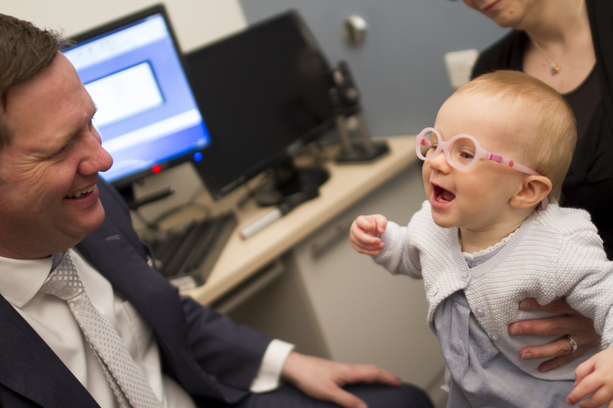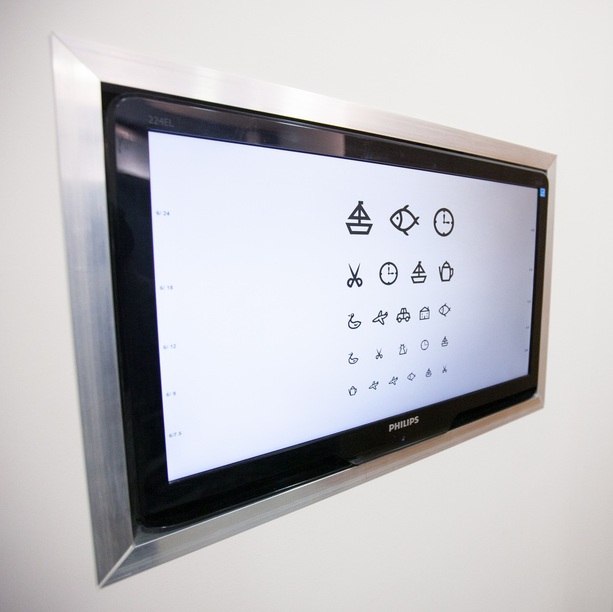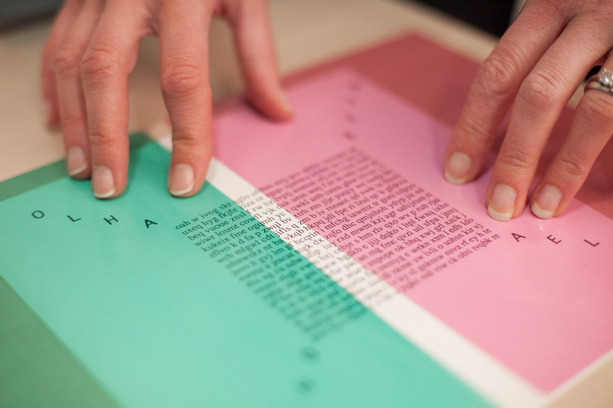Children's Eye Examination
- Examinations include peripheral eye scanning.
- Wide choice of children's glasses and sunglasses.
- Eye-tracking to help improve reading speed, fluency and accuracy.
- Irlen and coloured lens assessments.

Click here to find out the 12 signs your child needs an eye test now.
We recommend all children have their eyes tested before starting school. Ideally before three years old and sooner if they appear to have a problem i.e., one eye appears to be turning, or they do not appear to be able to see clearly at a particular distance. If you notice your child’s pupil appears to be white, this can be a medical emergency, and you should see your GP or Optometrist immediately to arrange appropriate investigations.
 Don’t worry if your child can not read letters yet; we have many specialist ways of checking their vision and examining their eyes without using letters or requiring them to sit still for too long!! We endeavour to make your child’s eye examinations as relaxed and fun as possible. We work at their pace and get them learning about tto learns and how to look after them. Most children enjoy their visits so much they hate leaving! (Maybe all the stickers and the PlayStation in the waiting area don’t help!)
Don’t worry if your child can not read letters yet; we have many specialist ways of checking their vision and examining their eyes without using letters or requiring them to sit still for too long!! We endeavour to make your child’s eye examinations as relaxed and fun as possible. We work at their pace and get them learning about tto learns and how to look after them. Most children enjoy their visits so much they hate leaving! (Maybe all the stickers and the PlayStation in the waiting area don’t help!)
Up to 1 million children in the UK currently have an undetected vision problem. Although 90% of children have regular dental check-ups, only 7% of children aged under 5 are taken to the opticians, yet at least 10% and possibly as many as a third of children in England may be at risk of avoidable and lifelong vision problems going undetected which can affect their education and cause permanent damage to their sight. However, most children do not complain as they are unaware of how clear things should be. Some children may appear to see well but suffer from reading difficulties due to the strain of constantly having to focus their eyes. 70% of schools do not have eye screening despite many parents believing they do.
We offer several advanced tests for children including:
Fundus Imaging
The fundus (retina) is the inner lining at the back of the eye. It acts in a similar way to the film in a camera, capturing the image of what we see and then transferring this image to the brain for interpretation.
Photographing the retina using our extremely advanced digital camera system allows the optometrist to take a very high-resolution detailed picture of your child’s retina. This allows even the smallest of problems to be spotted and therefore often allows for earlier detection of eye disease such as papilloedema (pressure behind the eye) and inherited eye problems.
By using magnification, filters and computer technology, it is also possible for the Optometrist to magnify certain areas of the retina to look at more closely-we can even see details in the walls of your blood vessels and tiny individual nerve fibres! Taking photographs doesn’t just allow detection of sight problems but may also reveal a range of other conditions such as diabetes, abnormal blood pressure, naevi (moles) and signs associated with brain tumours. Earlier detection of such conditions can save further health problems in the future.
After the images have been viewed and assessed, they are stored electronically for your child’s next visit, where any even tiny changes can be spotted by referring to the previous photo. This allows for an easier and more accurate method of monitoring the health of the eyes year after year. If necessary, the photographs can be passed on to GPs or Hospitals for their reference too.
The test usually involves looking at a blue dot and then there is a bright green light. The machine does not touch your child’s eyes or use any harmful radiation like x-rays. Fundus Imaging is recommended for all patients 5+ years.
Colour Vision
Colour vision deficiency is commonly known as colour blindness. True colour blindness, when people see things only in grey scale, is very rare. Most people with colour vision problems have an inherited red-green colour deficiency which leads to confusion of colours in that spectrum. Due to its inheritance pattern, it is most common in boys. Approximately 8% of boys and 1% of girls are colour deficient. There are other types of colour deficiency that can affect other colour groups as well. Red, green and blue cone cells at the back of our eyes detect colour variations. In colour deficient eyes one or more type of the cones may be absent or deficient therefore affecting the ability to perceive certain colours.
We check colour vision firstly in childhood to establish if there is an inherited problem and gain a baseline for future reference. Some colour deficiencies that occur later in life can be caused by illness, accident or poisoning. Colour vision is easy to check in all children from 2 years upwards (they don’t need to be able to read numbers or letters).
Testing Colour vision in childhood can help explain any difficulties a child may have naming colours or using the wrong coloured pens at school. It also helps plan for any impact it may have on a chosen career (certain jobs including certain military occupations, pilots, seafaring navigators and electrical engineers may be required to pass a colour vision test before starting the job).
Eye Tracking and Coloured overlay assessment
Coloured overlays and spectacles have been found to have beneficial effects for sufferers of both visual stress and reading difficulties, including many forms of dyslexia. Following a comprehensive eye test to rule out any prescriptive or ocular motor problems, an eye tracking assessment with one of our specialist optometrists will conclude if a coloured overlay or spectacles can help your child reduce visual stress, increase reading speed, and improve concentration.
Symptoms and signs of visual stress may include:
Discomfort when reading
Glare from a white page
Seeing Patterns in the print
Migraines
Blurring of print
Letters and words appear to be moving
Re-reading the same line frequently
Moving the book a lot to focus
Skipping or missing words
Poor concentration when reading
Click here to find out more about coloured overlay and eye-tracking screening.
Binocular vision
Is the ability of the two eyes to work as a pair. Binocular vision allows us to perceive depth and maintain a single image i.e., avoid double vision. Binocular vision problems can often be subtle and lead to signs of visual stress s such as:
Print jumping as you read
Difficulty focusing on individual words or letters.
Diplopia (double vision)
Tired eyes when performing visual tasks
Strabismus (squint)
At every eye examination, binocular visual balance will be assessed to ensure children are getting the most comfortable vision possible, eliminating signs of visual stress. If a binocular vision problem is identified, there are many methods we can use to help to alleviate symptoms including using prismatic correction in spectacle lenses and eye exercises.
Binocular vision problems may be present from childhood or develop later in life. Due to the rate at which children grow, their eye muscles can change rapidly. It is important that any eye muscle problems are identified early as there is often a limited period in which significant improvements can be made (this can be as young as 9).
If at any time you notice your child’s eye turning or squinting, book an eye examination as soon as possible even if they have been examined recently. As children grow so quickly problems with their eyes can change very quickly.
Slit Lamp Biomicroscopy
To accurately view the interior and exterior of the eye in 3D we use slit lamp indirect biomicroscopy- a technique which involves specialist skills and an advanced piece of equipment to view all the hard to reach corners of the eye. This technique can help us identify inherited eye problems, retinal bleeds, holes, tears and detachments far more accurately than traditional methods of looking in your child’s eyes (usually with a bright light called an ophthalmoscope). This technique is also less invasive than traditional methods of looking in the eye. It involves shining a light into your child’s eye and holding a lens in front of their eye to focus that image. We do not need to get very close to your child and only require them to sit still (on your lap if necessary) for a couple of minutes.
Children and contact lenses
You are never too young or old! Our current youngest wearer is 8 years old and our oldest 85! Throughout your life, contact lenses can be an excellent way to correct your vision and provide a change from wearing glasses. Children especially enjoy wearing contact lenses. It can boost the confidence of a shy or bullied spectacle wearer. It can improve vision correction over the long term by simply ensuring your child wears the correct prescription all day (rather than risking them taking the glasses off when nobody is looking!) It allows freedom to enjoy sports without the risk of injury or the inhibition of spectacles falling off or getting in the way. Most schools require pupils to remove spectacles for sports to reduce the risk of injury in the event of falling or being hit in the face. This often simply increases the risk of a child having a fall or accident and considerably raises inhibition and curtails enjoyment. Contact lenses are the ideal, safe, easy solutions. Children of any age are safe to wear lenses. And once taught by us how to safely insert and remove the lenses and how to look after their eyes, contact lens wear in children is as safe as adults.
We usually suggest daily disposable lenses as the first lens of choice for children. These lenses are the easiest to use and offer the best health benefits. They are also economical if your child should loose or break one. The lenses are single use thus eliminating the need to clean or store the lens which can be difficult for children to comply with.
Children often find contact lenses much easier to use than you may think. We spend a great deal of time explaining and showing them how to insert and remove the lenses. All our staff are extremely patient and experienced at working with children of all ages. Click here to find out more about contact lenses including Frequently Asked Questions.
Children’s Sunglasses
Children’s eyes must be protected from the sun to avoid putting them at risk of permanent damage to their sight. Read more about children's sun protection here.
Testimonials
"I took my daughter here for a second opinion. Thank goodness I did as she needed brain surgery after my original opticians failed to refer her to the hospital. The level of professionalism and care I received from Alisdair has been outstanding. We were made to feel very welcome, things were explained in a calm fashion and I am so grateful for saving my daughter's life. Alisdair called me after returning home from Kings College Hospital to see how my daughter was doing. I cannot recommend Buchanan Optometrists enough." Elizabeth
Book your child's appointment today on 01634 757227 or click HERE and we will call you straight back!





